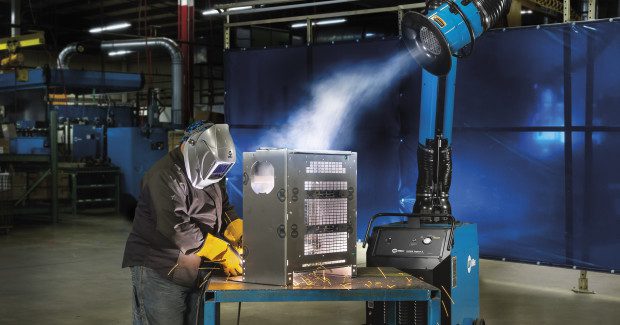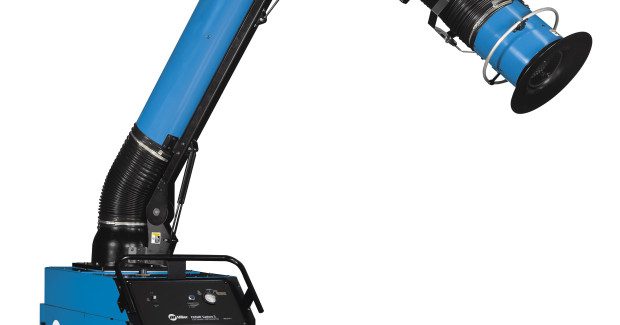Advanced Source Capture Technology Creates Larger Area for Weld Fume Capture
Employing source capture in the welding operation helps maintain compliance with regulations, avoid potential fines and create a safe and comfortable work environment. Because selecting the appropriate type of system for a given welding operation can be more difficult, here are some factors to consider in terms of cost, space requirements and the actual welding application.
Posted: April 30, 2014
This advanced technology is most effective when strong air currents or turbulence, such as fans or open doors, are kept at a minimum. Welding operators can manage such air currents by using welding screens, curtains or other similar partitions to block the stronger air movements. Make sure to maintain clearance of at least 5 ft on all sides of the fume extraction system when setting up a partition.
The fume extraction capabilities of these advanced systems also are best realized when the extraction arm is placed at 30 deg to 45 deg off horizontal, either in front or at the side of the weld area so that backfill air can flow freely and fume is pulled away from the breathing zone.
PRODUCTIVITY AND SAFETY BENEFITS
While exceptionally efficient at protecting the welding operator’s immediate breathing area, traditional source capture methods sometimes have arms that are difficult to position without significant welding operator interaction. This interaction can especially be an issue for applications with large weldments (such as those found in heavy equipment manufacturing or heavy fabrication) or areas within the weld cell that include obstructions. Applications with frequent, intermittent welds can also pose a problem.
The need to pause repeatedly for fume extraction arm adjustments can lead to downtime and, potentially, weld defects due to the repeated stops and starts in the weld. Some operators may even choose to forgo arm adjustments in an effort to meet productivity demands, which can lead to more fume in the weld cell.
The wider, deeper and more defined source capture zone created with the advanced technology results in less downtime for the welding operator to pause to reposition the arm; reduces the chance of obstructing the welding operator’s vision since fume is captured at a greater distance; and offers consistent extraction arm position for safety and quality.
Welding operators can adjust the zone capture area to be more narrow and direct. This adjustment prevents the discharge airflow from deflecting off parts or swirling around, and it increases suction. The feature also helps ensure that airflow won’t interfere with the shielding gas coverage and lead to weld quality issues.
The advanced source capture systems also feature automatic cleaning mechanisms. Every time the machine is shut down, it goes through a reverse pulse cleaning cycle, which cleans the filter from the inside out. The process removes weld fume particulates from the filter, depositing them into a drawer for later disposal. This cleaning cycle helps extend the filter life, maintain higher airflows, reduce the time spent on maintenance and minimize downtime for changeover.
OTHER SOURCE CAPTURE OPTIONS
Companies have different weld fume management needs and will want to consider the various methods to reduce weld fume exposure. In addition to the advanced source capture technology discussed previously, there are other options for creating a safe work environment. These fume extraction systems come in multiple shapes and sizes, with each type having its own advantages, considerations and best applications. Below are some details of other source capture offerings.
Portable models work well for applications in small spaces or hard-to-reach areas. They are also good for maintenance and repair operations or contract jobs where welding doesn’t occur on a regular basis. Portable fume extraction systems can couple with fume extraction guns that capture weld fume directly at the source via a fume chamber over the gun nozzle or by way of a flexible nozzle attachment. The attachments offer high levels of suction and employ small diameter hose or ducting with lower overall air volume, meaning the source capture distance is much closer to the weld, usually about 6 in away.
Mobile floor models feature an adjustable extraction arm that the welding operator can move toward the weld pool to remove the fume from up to 18 in away. These models work well in maintenance and repair operations, fabrication shops and manufacturing facilities where mobility is important or overhead obstructions make them necessary.
Stationary fume extraction systems are a good choice for companies with dedicated welding cells. They can be mounted on a column or wall and feature an extraction arm that is adjustable, so it is simple for the operator to shorten the distance to the arc and efficiently remove the weld fume from the area. Wall-mounted versions can be expanded to two arms, taking the footprint off the shop floor and allowing for more room in the weld cell to expand welding operations.
Centralized fume extraction systems offer fume capture capabilities ranging from 2,000 cfm to 60,000 cfm. Companies with multiple arcs or with robotic welding cells may want to consider this option. They can be customized with mechanical extraction arms, backdraft hoods and tables and/or overhead collection hoods that cover the welding area.
MAKING THE SOURCE CAPTURE DECISION
Employing source capture in the welding operation can help companies maintain compliance with regulations, avoid potential fines and create a safe and comfortable work environment for employees. Once a shop decides to implement source capture, selecting the most appropriate type of system for a given welding operation can be more difficult. There are considerations to make in terms of cost, space requirements and the actual welding application.
The advanced source capture technology discussed in this article greatly increases the fume extraction area and offers reduced operator interaction with the extraction arm, offering safety and quality benefits. It’s a good idea to consult with a trusted welding distributor or industrial hygienist to determine whether this technology or another type of fume extraction system is the best choice for the application at hand.

















